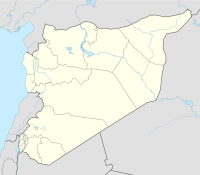Mumbaqat
| Alternate name | Tall Munbāqa, Ekalte |
|---|---|
| Location | Tabqa, Syria |
| Coordinates | 36°13′8.97″N 38°7′53.89″E / 36.2191583°N 38.1316361°E |
| Type | Tell |
| Part of | Settlement |
| Site notes | |
| Archaeologists | Winfried Orthmann, Alfred Werner Maurer, |
| Condition | ruins |
| Public access | Yes |
Tall Munbāqa (also Ekalte (Mumbaqat)) is a 5000-year-old town complex in northern Syria now lying in ruins.
The ruins are located on the east bank of the upper course of the Euphrates, on the steep slope of the former river valley. In the 3rd and 2nd millennium BC, the city was an important city-state in the region. Due to the establishment of the Tabqa Dam at Al-Thawrah, 35 kilometers west of Raqqa, the city ruins are partially flooded today. The situation in the dam area has changed dramatically in the years since the establishment of the excavations in 1969. In the Euphrates valley, whose image was marked by the green of the cotton and the wide river, a large artificial lake has been formed, which has partially flooded the ruined city. It most affected the west bank, with its flat river terraces that were flooded first. Situated high above the steep drop of the eastern shore, Tall Munbāqa is still preserved.
The exposed during the 1974 excavation East Gate is located on ♁ 36 ° 13 '9 " N , 38 ° 7 '54 " O36.219159 38.131635, the south gate on ♁ 36 ° 13 '1 " N , 38 ° 7 '44 " O36.217047 38.12891 . The exposed during the 1974 excavation East Gate is located on ♁ 36 ° 13 '9 " N , 38 ° 7 '54 " O36.219159 38.131635, the south gate on ♁ 36 ° 13 '1 " N , 38 ° 7 '44 " O36.217047 38.12891 .
The Euphrates was one of the highways, the Asia with the Mediterranean combined. Of course one of the main trade routes between the Sumerian and later Babylonian centers of power and the Syrian coastal cities and the immediate access to the main navigable river can be considered as one of the basic motives for founding this city. Trade was driving to urban planning. Town authorities and city destruction characterize the Urbanisationsfieber of the 3rd and 2nd millennium BC in northern Syria, where the river from the Armenian highlands turns to the south-east, 200 km from the nearby Mediterranean were major trading centers. From there, the road passes over the northern Syrian plateau of Aleppo. Starting from the 4th millennium BC, Sumerian trading sites are detectable here. In the 3rd millennium, the height of the cultural and economic development, according to the model developed chiefdom Sumerian cities. The Old Syrian kingdom reached the 2nd millennium BC to the Euphrates. The Mitannistaat the Hurrians dominated a few centuries out the northeast of the modern-day Syria to the Euphrates. In the 14th century BC ruled the Hittites northern Syria and the Euphrates was the boundary area between the Assyrian and Hittite Empire. Around 1200 BC settled the Syrians on the Euphrates. This eventful history may be seen from the numerous ruins of hills along the 90 km long reservoir. One of the largest excavated ruins of this ancient cultural landscape Tall Munbāqa.
...
Wikipedia

